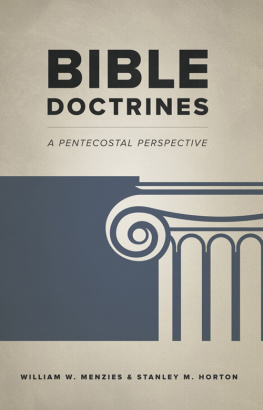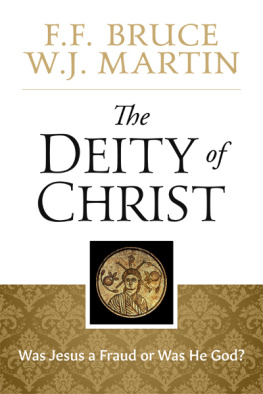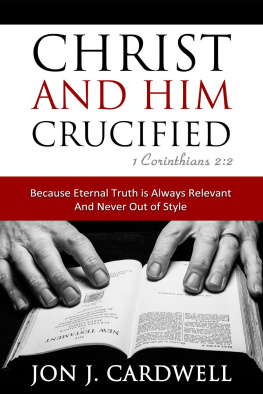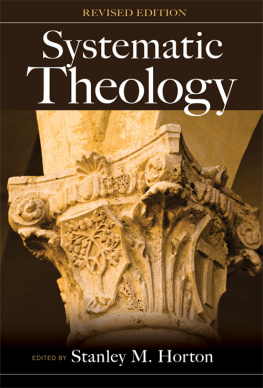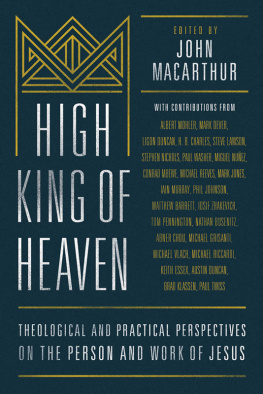Unless otherwise indicated, all Scripture quotations are taken from the HOLY BIBLE: NEW INTERNATIONAL VERSION. NIV. Copyright 1973, 1978, 1984 by the International Bible Society. Used by permission of Zondervan. All rights reserved.
2012, 1993 by Gospel Publishing House, Springfield, Missouri 65802-1894. All rights reserved. No part of this book may be reproduced, stored in a retrieval system, or transmitted in any form or by any meanselectronic, mechanical, photocopy, recording, or otherwisewithout prior written permission of the copyright owner, except brief quotations used in connection with reviews in magazines or newspapers.
Bible
Doctrines:
A Pentecostal
Perspective
The study of Bible doctrines is very important, especially in these days when the number of false prophets and false teachers is increasing. Too many Christians are being tossed back and forth by the waves, and blown here and there by every wind of teaching and by the cunning and craftiness of men in their deceitful scheming (Eph. 4:14). Unfortunately, some believers (perhaps not realizing that doctrine is simply another word for teaching) object to the study of doctrinejust what the propagators of false doctrine would like a person to do. This then makes one a likely candidate for their wind of teaching. Thats why God wants Christians to grow to the point that they know the basic teachings of the Bible. Such knowledge will protect them from false teachers and false doctrine.
The book Understanding Our Doctrine, by Dr. William W. Menzies, was originally written as a unit in a training course entitled Fundamentals for Sunday School Workers. Dr. Menzies, currently president of the Asia Pacific Theological Seminary (formerly Far East Advanced School of Theology) in Baguio, Republic of the Philippines, gave me his kind permission to revise and enlarge his excellent book for general use.
The chapters in the book follow the sixteen points of the Statement of Fundamental Truths, as accepted by the Assemblies of God. Our purpose, however, is not to promote Assemblies of God doctrines, but tot bring out the biblical basis and applications of these fundamental Bible truths. Thus, this study will be helpful to those who believe the Bible, whatever their denomination or background. Christians need to know where they stand with respect to Bible doctrines.
Pastors will find the book useful in the training of new converts. Sunday school teachers will find it useful either for course work or as background for their teaching. Bible college students will find it giving them a solid basis for further studies in theology.
I wish to thank Dr. G. Raymond Carlson, general superintendent of the Assemblies of God; The Assemblies of God Theological Seminary; Central Bible College; the Division of Foreign Missions of the Assemblies of God; and others who by their generosity have made this project possible. Special thanks are due also to Glen Ellard and his editorial staff for their expert help.
For easier reading, Hebrew, Aramaic, and Greek words are all transliterated with English letters.
A few abbreviations have been used:
Gk.: Greek
Heb.: Hebrew
KJV: King James Version
NASB: New American Standard Bible
NIV: New International Version
STANLEY M. HORTON, TH.D.
DISTINGUISHED PROFESSOR EMERITUS
OF BIBLE AND THEOLOGY
AT THE ASSEMBLIES OF GOD
THEOLOGICAL SEMINARY
Bible
Doctrines:
A Pentecostal
Perspective
The Assemblies of God came into being as a result of the Pentecostal revival that began early in the twentieth century. This revival came as Gods mighty supernatural answer to Modernism, the antisupernatural religious liberalism that was taking over the major Christian denominations in America and around the world. Books written to defend the faith were being ignored by the seminaries that trained their ministers. The possibility of God-given miracles was denied. A spiritual vacuum was developing. As Dr. William Menzies points out:
The United States in the years between the Civil War and the close of the [nineteenth] century was in social and religious ferment. Moral, political, and economic corruption increased the stresses occasioned by urbanization, industrialization, and immigration. The great denominations, successful in Christianizing the frontier, had become complacent and sophisticated, lacking the vision and vitality to meet the changing needs of a distressed populace. Varying degrees of accommodation to popular ideas, newly imported from Europe, which assaulted orthodox Evangelicalism, further weakened the great communions. Against the erosion in the church
The current Pentecostal movement traces its origin to a revival at Bethel Bible College in Topeka, Kansas, that began on January 1, 1901. Students, from their studies of the Bible, concluded that speaking in tongues (Acts 2:4) is the initial outward evidence of the baptism in the Holy Spirit. One of the students, Agnes Ozman, said she felt as though rivers of living water were proceeding from [her] innermost being.
The revival became a Pentecostal explosion when, in 1906, W. J. Seymour secured an old two-story frame building at 312 Azusa Street in Los Angeles, California. For about three years services ran almost continually, from ten in the morning to midnight. Many of those who received the Pentecostal baptism in the Holy Spirit there scattered to spread the message. Many independent Pentecostal churches sprang up. Then,
After the Pentecostal outpourings began, numerous publications appeared advocating its teachings and serving as channels for teaching information, and the support of missionaries overseas. One of these publications, the Word and Witness edited by Eudorus N. Bell, issued a call in 1913 for a conference of Pentecostal believers to convene in Hot Springs, Arkansas, the following year. This became the founding meeting of the General Council of the Assemblies of God.
It was adopted with the following preamble:
This statement of Fundamental Truths is not intended as a creed for the church, nor as a basic of fellowship among Christians, but only as a basis of unity for the ministry alone (i.e., that we all speak the same thing, 1 Cor. 1:10; Acts 2:42). The human phraseology employed in such statement is not inspired nor contended for, but the truth set forth in such phraseology is held to be essential to a full Gospel ministry. No claim is made that it contains all truth in the Bible, only that it covers our present needs as to these fundamental matters.
The original statement served the Assemblies of God well for many years. There was little dissatisfaction with any of the sixteen points.
The concern for the preservation of doctrinal integrity within the Movement has also resulted in a number of position papers. These papers were called for by ministers of Assemblies of God churches from time to time, as the need for further help and clarification on various subjects was felt on the field. Most of them were prepared by the Commission on Doctrinal Purity, a standing committee appointed by the Executive Presbytery of the Assemblies of God. A number of pastors, district officials, and professors of the Bible colleges and seminary have served on that committee at various times. The papers were approved by the Executive Presbytery and the General Presbytery, the leadership bodies of the Assemblies of God, and then printed. All papers up to 1989 have been collected and published under the title

